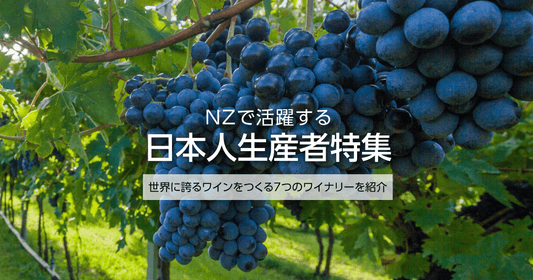
"New Zealand wine is now captivating wine fans around the world."
This is a fact.
However, if you were to suddenly say that, many people might think, "Really?"
In Japan, when speaking of wine countries, many people first think of France. In addition, wines from Chile, Italy, Spain, and Australia are prominent in the wine sections of liquor stores and supermarkets, but you may not have many opportunities to see New Zealand wines.
Looking at the data, New Zealand is ranked 11th in terms of countries that import wine to Japan, so it is still a rather modest presence.
But global presence is a different story.
"Once you try New Zealand wine, you'll never forget the taste!"
"This store has great taste by stocking New Zealand wines."
"I want to drink New Zealand wine on a special occasion."
Now, such voices are being heard from all over the world.
Why?
This is because New Zealand wines have a distinctive character that clearly stands out from wines from other countries.
The fact that the wine has a distinctive character means that the taste is remembered in the brain. It can be said that wine fans around the world remember the "taste of New Zealand" as "a taste with a strong character."
We will tell you about the characteristics of NZ wine, including its unique characteristics, history, grape varieties, etc.
What are the characteristics of New Zealand wine? And its history?
Now, as I mentioned briefly at the beginning, what is the strong character of New Zealand wine?
The answer is simply "the aroma and flavor of Sauvignon Blanc."

Wines made from Sauvignon Blanc (a white wine variety) grown in New Zealand pack a punch.
The moment you smell it rising from the glass, you are hit with the aroma of an abundance of fruit, making you feel as if you were in an orchard.
And when you take a sip, you'll be amazed by the bursting fruit flavor. It has such a strong fruity and juicy flavor, with the refreshing herbal taste, that you'll almost think it was made from grapefruit or herbs.
This distinctive aroma and flavor is what sets Sauvignon Blanc apart from other countries.
"Of all the Sauvignon Blancs in the world, New Zealand Sauvignon Blanc is something special."
It is recognized that:
Furthermore, in recent years, there have been many red wines that are just as high-quality as those in France, and they are available at more affordable prices than in France.
In recent years, people who previously only drank European wines have begun to choose New Zealand wine, and supermarkets and restaurants around the world are purchasing large quantities of New Zealand wine, wanting to stock it in their stores.
In response to this demand, New Zealand wine exports have grown rapidly, and currently account for 80% of total production.
History of New Zealand wine
Now let's take a look at the history of New Zealand wine, the world's most fascinating wine.

The first surprising fact is that it has only been around 40 years since New Zealand began producing world-class wines .
Unlike in Europe, there are few winemakers whose winemaking traditions have been passed down from generation to generation, and most producers are relatively new, being first or second generation producers.
Until the 1970s, dairy farming and livestock farming were the main industries in New Zealand. Dairy products and meat were famous, but there were only a handful of wineries. Of course, there was almost no wine export.
However, in the 40 years since then, the number of wineries has increased rapidly (currently exceeding 670), and wine exports have grown to over 130 billion yen per year, making it an industry that supports the country.
The background to this...
- In the 1970s, New Zealand, which was once thought to be too cold for growing grapes, discovered a vast area suitable for growing grapes: Marlborough.
- It is in Marlborough that the aforementioned "Sauvignon Blanc that captivates the world" began to be mass-produced.
- In order to catch up with the traditional European countries, many producers are studying hard and improving their skills, and high-quality wines are being produced one after another.
It is these factors that have given New Zealand the reputation it enjoys today.
Beginners should learn about grape varieties through New Zealand wines
Wine is made from 100% grapes and generally contains no water.
In other words, the aroma and flavor of wine is determined by the type of grapes used.
The world of wine may seem somewhat complicated, but once you get into the habit of tasting wine while keeping in mind the variety and country of the grapes used, you will gradually begin to understand the differences.
At this point, I would recommend choosing different varieties of wine from the same country to increase your experience .
Japan is a country that imports wine from all over the world.
It's good to be able to enjoy wines from various countries, but if you choose them just because "the label looks good" or "the price is reasonable," you won't be able to learn them systematically. This will only increase the number of times you get drunk, and your wine knowledge will not improve.
So let's narrow it down to countries for now.
The quickest way to become good at wine is to try different varieties of wine made in one country. This way, you can easily learn the characteristics of "this variety from this country."
And New Zealand wines are a great way to put this method into practice.
because····
First of all, there are generally few blended wines . Most wines are made from a single variety, so it is easier to capture the individuality of the variety without any distortion.
Secondly, each variety has its own easily recognizable character . It could be said that there are few wines from this country that have complex or tricky flavors.
Thirdly, the varieties grown in New Zealand are all major varieties that are grown all over the world , so if you can get a foundation in New Zealand, you can easily apply that knowledge to other countries.
We encourage you to use this website to try and learn some basic knowledge about wine using New Zealand wines.
On this page we will go into more depth about these basics.
There are links for each grape variety and production area, so if you're interested, please click on them and read on.
New Zealand Wine Grape Varieties
As mentioned above, the most important white wine grape variety is Sauvignon Blanc. Sauvignon Blanc accounts for an overwhelming 76% of New Zealand wine.
By the way, the share of Koshihikari, the representative variety of rice in Japan, is only 33% of the total. This shows how much Sauvignon Blanc is the country's representative variety.
| Variety (white) | Features |
|---|---|
| Sauvignon Blanc | Citrus and herbal aromas. Very fresh and refreshing. A variety synonymous with New Zealand wine. Accounts for 76.5% of total production (2022). |
| Chardonnay | The world's most popular white wine grape variety. In New Zealand, it is overshadowed by Sauvignon Blanc, but is still popular as an ingredient for high-quality wines. |
| Pinot Gris | It has a honey-like aroma and in New Zealand it is brewed in a slightly full-bodied style. |
| Riesling | Characteristic aromas of green apples and kerosene. Strong acidity. Available in sweet to dry flavors. |
| Gewurztraminer | Aromas of lychee and pineapple. Unique aroma. Available in sweet to dry flavors. |
Next, we have red wine grapes.
Although the production volume is small compared to white wine grapes, most of the grapes produced are of high quality.
Pinot Noir in particular has received high praise from wine lovers and critics around the world.
| Variety (red) | Features |
|---|---|
| Pinot Noir | Elegant and delicate in flavour. Central Otago is the leading producer. It accounts for 6.7% of the total. |
| Merlot | A blend variety often used in red wines. Elegant and mellow in flavor. |
| Sangiovese | It is a typical Italian variety and has a wide range of flavors. |
| Syrah | A spicy, powerful and wild grape. In Australia it is called "Shiraz". |
| Cabernet Franc | An ancestor of Cabernet Sauvignon. Soft, smooth and slightly light on the palate. |
| Cabernet Sauvignon | A typical red wine grape. It is rich in tannins (astringent compounds) and has a firm structure. |
| Petit Verdot | A dark, astringent grape. Rarely used on its own. Used as a complementary variety in red wine blends. |
| Malbec | It has such a rich flavor that it is also called black wine. It is a variety that has been very successful in Argentina. |
New Zealand wine regions
New Zealand consists of the North Island and the South Island. Because it is located in the Southern Hemisphere, the direction in which the sun rises and the four seasons are all opposite to those in Japan.
In terms of climate, the North Island is warmer than the South Island.
▶ New Zealand tourism information and other information other than wine
The most important wine producing region is Marlborough, in the far north of the South Island.

Marlborough is New Zealand's most important wine producing region, producing over 70% of New Zealand's wine.
Most of the New Zealand wine available in Japan comes from the Marlborough region. Marlborough is such a well-known region name that it is synonymous with New Zealand, so be sure to remember it.
Once you've memorized Marlborough, it's time for the next step. This might be a bit technical, but if you come across a place name other than Marlborough on the label, check the table below for its characteristics.
By the way, in Japan, wine origins are often divided by prefecture name and region, such as "Wine from Katsunuma district of Yamanashi prefecture," but in New Zealand it's a little different.
In Japan, a region that combines a local area name and a prefecture name (such as Yamanashi Prefecture in the Koshinetsu region) is called a "region" and is written simply as "XX region." In other words, the most representative region is the Marlborough region.
In Japan, "△△ region" is called a "subregion" and is used like this: "Marlborough's subregions include Wairau Valley, Southern Valley and Awatere Valley."

Now, let's take a closer look at the production area.
Let's start with the North Island.
There are five wine regions in the North Island, including New Zealand's largest city, Auckland, and its capital, Wellington.
| North Island | Features |
|---|---|
| Northland | This is the area where grape vines were first planted. Quite warm. |
| Auckland Region | New Zealand's largest city. Waiheke Island, also known as a resort area, is also known as the "Wine Island." |
| Gisborne Region | The easternmost wine-producing region. Famous for its Chardonnay cultivation. |
| Hawke's Bay | It is the second largest producer after Marlborough and the largest producer in the North Island. It accounts for approximately 7.8% of New Zealand's total production (2022). With abundant sunshine, the production of red wine grape varieties is thriving. |
| Wairarapa | The region, called Martinborough, is known for its Pinot Noir. |
Next, the South Island.
There are four regions in the South Island.
This region is home to high mountains (the Southern Alps) that stretch from north to south, which block rain clouds and make it easy for grapes to grow.
| south island | Features |
|---|---|
| Marlborough Region | It is world-famous as an unrivaled producer of Sauvignon Blanc, and is the most important producer in New Zealand, accounting for 77.7% of the total production. |
| Nelson Region | Located on the west side of Marlborough, it enjoys plenty of sunshine and is famous for growing fruit and for producing hops, an ingredient in beer. |
| Canterbury/Waipara Region | The city is dotted with wine-producing regions across a wide area, and is home to the prestigious Lincoln University, which has produced many winemakers. |
| Central Otago | It produces high-quality Pinot Noir that rivals that of Burgundy in France, and has attracted worldwide attention. It also produces many high-quality aromatic white wines. |
A miraculous climate where it is said that there are "four seasons in one day"
As mentioned above, each wine producing region has its own unique characteristics, but the general impression of the climate throughout New Zealand is that it is somewhat cool and comfortable .
One of the main reasons for the rapid spread of winemaking in New Zealand is that the country's climate is ideal for growing grapes.
Among them...
The temperature difference is so extreme that it is said that there are four seasons in one day.
This creates the perfect conditions for growing grapes.
In New Zealand, even in summer, it gets quite cool after the sun goes down, so you'll need long sleeves in the mornings and evenings.
If grapes ripen all at once in a hot place, they lose their acidity and become less tasty. Grapes prefer an environment where they can grow slowly while receiving plenty of summer sunshine.
During the day, the vines create nutrients through photosynthesis, and when the temperature drops at night, the vines stop functioning. They then wait until the next morning to create more nutrients during the sunny day, without losing the nutrients they stored during the day.
This optimal cycle can be created in places where there is a large difference in temperature between day and night.
However, until the 1970s, although there were favorable conditions such as a large difference in temperature between day and night, the climate was still considered too cool overall, and it was difficult to find varieties that would grow well in this climate.
However, the cool-climate-loving Sauvignon Blanc variety was successfully planted in Marlborough, proving that New Zealand could produce quality wine.
Winemaking with original ideas possible in a developing country
New Zealand has a short history of winemaking: the first grapes were planted around 200 years ago, and it has only been about 40 years since commercial wine was produced there.
However, this short history does not put New Zealand at a disadvantage in the world of wine. There are many ambitious winery owners in New Zealand who want to catch up with, or even surpass, Europe, and they are making wines that are not bound by tradition.
The current wine-making methods have been established mainly in Europe over hundreds or thousands of years, and as such, they are a mixture of ancient traditional methods and modern technology, which has made cultivation and brewing more scientific.
Many New Zealand wineries focus on modern technology and make wine in a very streamlined way.
"Rational" here does not mean mechanical, but rather that we decide on our own style based on the results of research conducted in various locations.
Starting with deciding where to plant the grapes, what varieties to use, what kind of wine to make, and how to sell that wine, they study hard and pore over research data in pursuit of their own unique flavor.
As one New Zealand wine industry source said:
"We joined the wine party late, so it's natural that we're working hard to catch up."
Screw cap adoption rate is over 99%
Traditionally, wine bottles were sealed with natural corks, but synthetic corks and "screwcaps" that can be opened without a corkscrew are now widely used.
In New Zealand, screw caps are used on over 99% of bottles.
This is because natural cork carries the risk of introducing a foul-smelling substance known as "cork taint," and most wineries believe that it is better to keep the risk as low as possible.
This could be seen as a characteristic unique to a new wine-producing country that seeks rationality.
However, there is some debate as to whether screw caps prevent the wine from aging properly in the bottle .
However, there are many cases where screwcapped wines have actually aged well after being stored for years, and there are some wineries in New Zealand that use screwcaps even for high-end wines.
A country full of boutique wineries
Nearly 90% of New Zealand's wineries are small, family-run wineries known as boutique wineries.
The advantage of being a boutique winery is that they can pay attention to every detail, such as caring for the vines, harvesting, selecting, and brewing. This is why New Zealand produces many high-quality wines that reflect the individuality of each winery.
However, the fact that the winery is small and requires a lot of time and effort means that the prices are somewhat high. If you want to taste wine from a boutique winery that specializes in wine, it will usually cost more than 2,000 yen in Japan.
Making organic wine in the great outdoors
More than 94% of New Zealand wine producers are organic or sustainable wineries. Many wineries meet New Zealand's strict organic standards called "BioGro," and they actively practice organic farming that makes use of the power of nature, avoiding reliance on pesticides as much as possible.
The image of New Zealand's great outdoors and the organic wine that is a gift from that nature perfectly matches that of the country, and as the trend toward organic products continues to grow worldwide, it is now accepted as a highly valuable item.






